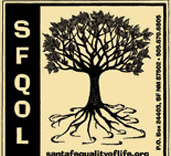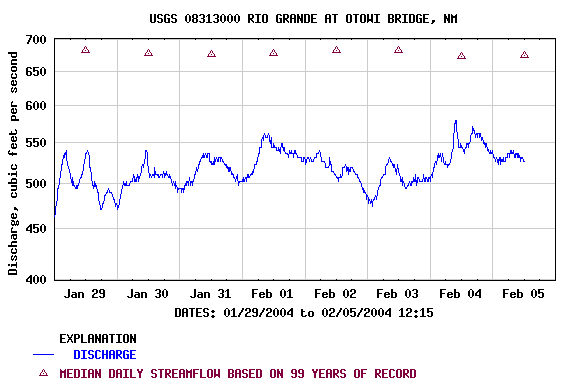
copyright 2004 by George Johnson
Part 1. Rebecca's House and Ludwig's Castle
Part 2. The Chamber of Commerce's (Not So) Secret Candidate
Part 3. David Pfeffer's Letter and Mayor Delgado's Award
Part 4. Tom Mills and the Elusive Qualities of Life
Part 5. The Great Masquerade: Memories of the 2002 Campaign
Part 6. Why Nature Abhors a Vacuum: Political Coverage, Santa Fe Style
(Brief Interlude: What the Water Budget Really Means)
Part 7. Into the Heart (and the Soul) of Santa Fe
February 1, 2004
Part 4. Tom Mills and the Elusive Qualities of Life
Last month when Santa Fe Quality of Life, the latest political creation of Chamber of Commerce vice chairman Tom Mills, made its debut, I felt a sense of deja vu.

Such a vague conclusion hardly seemed worth the cost of commissioning a poll. Did voters believe there should be more construction to increase the housing supply, or less to conserve water? Did they want the city to drill more wells to support new subdivisions, or to limit development so there is enough water for existing residents? Pressed by a New Mexican reporter for some specifics, Mr. Mills demurred. The data, he said, was "proprietary."
On further reflection, the group has apparently decided to be more forthcoming. In this morning's New Mexican, Tom Sharpe describes just what the survey found. It is clear why Mr. Mills's initial impulse was to keep it secret.
As the story reports, 63 percent of those polled believe Santa Fe is growing too fast; 57 percent believe the City Council is more inclined to protect business interests than neighborhood interests; and 61 percent said they support the city's minimum-wage law. All of this must have come as an unpleasant surprise for Mr. Mills's organization. Commendably, it ultimately decided to post the full report on its website.
This change in strategy suggests that Santa Fe QOL is more politically sophisticated than TAP. But it's basically the same set of characters.
In addition to Mr. Mills, Santa Fe Quality of Life board members include Wayne Lloyd, of Lloyd and  Associates architects, a firm best known for designing the Eldorado Hotel (it also has the contract for the proposed Santa Fe Convention Center); Jeff Mahan, representing the Santa Fe Lodgers Association; and Gary Ehlert, executive director of the Santa Fe Area Home Builders. Each, in one capacity or another, serves on the Chamber of Commerce board. Mr. Mills is a vice chairman.
Associates architects, a firm best known for designing the Eldorado Hotel (it also has the contract for the proposed Santa Fe Convention Center); Jeff Mahan, representing the Santa Fe Lodgers Association; and Gary Ehlert, executive director of the Santa Fe Area Home Builders. Each, in one capacity or another, serves on the Chamber of Commerce board. Mr. Mills is a vice chairman.
The chairman of the Chamber board, Buddy Roybal, owner of Coronado Paint and Decorating, is a spokesman for Santa Fe Quality of Life. And, as John Huddy reported last week in Journal North, donations to the group will be funneled through the Chamber's bank account, taking advantage of its 501c3 tax-deductible status.

Some of Santa Fe QOL's other members, like Edward Archuleta, a real estate broker known for his work with 1000 Friends of New Mexico, and consulting hydrologist Jim Corbin, may provide a more balanced outlook, as might representatives from the Santa Fe Symphony Orchestra, the Institute of American Indian Arts, and other seemingly neutral organizations. But it is hard to shake the suspicion that, at the core, the group's idea of "quality of life" bears little resemblance to that of most Santa Feans. Unless it takes to heart the conclusions of its own poll.

Postscript: It seems I was a little too easy on Santa Fe Quality of Life. As some readers have reminded me, the group's telephone survey also included pointed questions about incumbents Heldmeyer and Chavez that were clearly intended to prod for weaknesses to be exploited by the stealth Chamber candidates, Rick Berardinelli and Carmichael Dominguez. There is nothing wrong with that. But when SFQOL came clean with its survey results, it did not acknowledge the partsan nature of the enterprise.
Mr. Dominguez, who is running in District 3, distinguished himself earlier this year with a political statement that reminded me of one by James Watt, Secretary of the Interior under Ronald Reagan.
Mr. Watt: "The earth was put here by the Lord for His people to subdue and to use for profitable purposes on their way to the hereafter."
Mr. Dominguez: "Mother Nature gives us water to use; she did not give it to us to manipulate it and to use fear to try and support a no-growth agenda."
February 3, 2004
Part 5. The Great Masquerade: Memories of the 2002 Campaign
I had the feeling there was something funny about Rebecca Wurzburger when I first saw her two years ago at a candidates' forum. This was one of those civilized affairs sponsored by the Neighborhood Network, and I found myself impressed with her articulate responses. She was clearly smart, savvy and someone who did her homework. 
What bothered me was how she described herself: "a consultant helping families build homes." The phrase had the whiff of phoniness, like something cooked up by a political consultant who had attached electrodes to a roomful of potential voters and measured their galvanic responses to various buzz words. Why couldn't she just say that she made her livelihood from the construction business?
There was no way for me to know -- the newspapers didn't report it -- that her campaign had been designed by Eli Lee, an upcoming young Korean-American political consultant from Albuquerque. His company, Soltari (listen to the "whoosh" when you click the link), specializes in coaching liberal Democrats and activist political groups. Soltari (from the Spanish word for sun and the Korean word for bridge) is pro-labor, pro-environmentalist, listing as its heroes the likes of Cesar Chavez, Gandhi, even Muhammed Ali.

Mr. Lee, as one observer later put it, created the Wurzburger persona -- the cool, unflappable professional with the expertise (a doctorate degree in public administration and planning from USC) to grapple with the city's complex social and environmental issues.
The result was surely the slickest campaign in Santa Fe history. Henceforth she would not be known as "Wurzburger," which sounds like a kind of cheese, but "Rebecca," the name written in stylish cursive on her designer blue-and-white campaign signs. She soon won the endorsement of Cris Moore, the popular Green Party incumbent who had decided not to seek a third term. For many of us there could be no stronger recommendation. Maybe her connection to the construction business wasn't so defining after all. Not long afterward, I spotted a neighbor who belongs to the Sierra Club canvassing for her door to door.
Meanwhile, the other candidate who impressed me was, to my great surprise, Joe Hoback, proprietor of the Pink Adobe restaurant. His Chamber of Commerce links gave me pause, but his charismatic, almost Kennedyesque nature was winning. He seemed like a man who could accomplish something. I just wasn't sure what.
These were clearly the contenders (the other two serious candidates struck me as well-meaning but ineffectual). When Mr. Hoback came out in favor of a moratorium on hotel construction, I decided he had my vote. But at that point I could have easily gone the other way.
It was only in the final days of the campaign that I got a hint of what had been going on behind the scenes. A tiny item buried in the back pages of the New  Mexican listed the candidates' largest contributors. I was astonished to see that the seemingly progressive Dr. Wurzburger was receiving big checks from interests like Coppola Concrete, Ossorgin Construction, and William Parker, the developer of Ponderosa Ridge, the luxury subdivision adjacent to Wilderness Gate.
Mexican listed the candidates' largest contributors. I was astonished to see that the seemingly progressive Dr. Wurzburger was receiving big checks from interests like Coppola Concrete, Ossorgin Construction, and William Parker, the developer of Ponderosa Ridge, the luxury subdivision adjacent to Wilderness Gate.
None of this had been predictable from the perfunctory coverage in the press. Nor had the information emerged in any of the public debates. The New Mexican, Journal North, even The Reporter, all rushed to endorse Rebecca.
Just before the election, Joe Hoback happened to be campaigning in my neighborhood. He knocked on my door and we talked for a while about his opponent. Even after the earlier revelations, I was surprised to learn that her campaign treasurer, Yvonne Montoya (a name, then meaningless to me, which appeared in small type at the bottom of the Wurzburger ads) was the wife of Richard "Dickie" Montoya Jr., who, along with Dickie Senior is one of the biggest developers in town. At the time he was planning to build a new hotel in District 2, off St. Michael's Drive.
I asked Mr. Hoback why he hadn't made an issue of this -- it would have been the kiss of death for his opponent -- or publicly mentioned any of Dr. Wurzburger's other well-heeled supporters. "I didn't want to engage in negative campaigning," he said.
I still find this comment dumfounding. Since when is revealing your opponent's base of political power negative campaigning? The result of this misplaced politeness, which the other District 2 contenders seemed to share, was an electorate that went to the polls woefully uninformed, a mass of voters who now -- many of them -- seethe each time the Wurzburger-Pfeffer-Robertson-Ortiz quadrumvirate casts another vote on the side of the developers.
The coverage of the 2004 campaign has been better. Tom Sharpe at the New Mexican and John Huddy at Journal North have written some insightful pieces, as has Karen Peterson, Journal North's editorial page editor.
But so much still goes unreported. Nowhere do we read that the campaigns of the stealth Chamber of Commerce candidates, Rick Berardinelli and Carmichael Dominguez, are being run by Eli Senna, a professional political operative who also managed the Wurzburger campaign. (Council candidates more commonly rely on volunteers.)
Meanwhile the other Eli, Mr. Lee, is also playing a small role in this year's races. More about that later, unless (I can only hope) I am scooped by the dailies.
February 4, 2004
Part 6. Why Nature Abhors a Vacuum: Political Coverage, Santa Fe Style
This morning's two newspaper stories about the Chamber of Commerce candidates forum typify what is wrong with campaign coverage in Santa Fe. Both were perfectly good accounts written by talented pros. But existing within the vacuum of political analysis and commentary that is suffocating this town, the articles could do little to enlighten voters on the power struggles playing out behind the scenes.
It's not the reporters' fault. I liked how, instead of careening all over the map (which is easy to do in a piece like

 ("I despise the fact that this City Council has politicized one of Mother Nature's natural resources") and Mark Bentley (running in District 4) making the extraordinary claim that "This is the most anti-business council I think we've ever had." This in a city where every new housing development or Cerrillos Road big box nightmare is routinely approved.
("I despise the fact that this City Council has politicized one of Mother Nature's natural resources") and Mark Bentley (running in District 4) making the extraordinary claim that "This is the most anti-business council I think we've ever had." This in a city where every new housing development or Cerrillos Road big box nightmare is routinely approved.
What is so frustrating is that good material like this appears out of the blue without any political context. The city is crying out for a Steve Terrell to write an insider's column on city hall, or a William Stewart (or his inverse) to analyze Santa Fe's own internal wars . . . Or for an ambitious New Mexican editor who is not content to plug the holes in the op-ed page with canned wire-service copy (easily available elsewhere) or with every single letter to the editor, chopped to a couple of paragraphs, that comes through the door. How many snippets can anyone possibly read praising or excoriating, in 150 words or less, Howard Dean or George Bush or Molly Ivins or Charles Krauthammer, or commending another considerate driver for stopping to help change a flat tire? The emphasis is on filling space instead of filling minds.
The Reporter is much worse. The absentee owners seem determined to complete the transition from a scrappy, must-read community newspaper to another dreary "alternative weekly." So far the Reporter's scrutiny of the council races has consisted of cutesy Q&A's in which the editors try to stump the candidates with trivia questions. This would be funny

Postscript: I had an interesting conversation this afternoon with Eli Lee of Soltari about his work with a labor-based group, the Working Families Political Committee, on behalf of the four incumbents: Councilors Heldmeyer, Bushee, Chavez, and . . . Matthew Ortiz. (This is not quite as weird as it sounds for reasons to be explored here later on.) I was glad to learn that Mr. Lee had just received a phone message from John Huddy. So watch Journal North tomorrow for more details.
* Journal stories, alas, require an online subscription.

Postscript 2. Having received a thoughtful email from John Huddy, I want to make sure I was clear about what I mean. I wasn't referring to the context a reporter sets in a single story but the context that a newspaper sets over the weeks and months of political coverage.
The motivation of the challengers runs deeper than simply blaming the incumbents for legislative gridlock. That is what the Chamber candidates and their backers would have the public believe -- that a crop of fresh faces is taking on the Marcy Street irregulars. "Throw out da bums" is always a dependable campaign cry.
But burrow down another level: Why has there been gridlock? Because the council has been evenly divided between the pro-growth and anti-growth factions. Expelling any one of the incumbents -- except Councilor Ortiz -- would mean a council dominated by the developers. In this regard it hardly matters who wins the District 4 seat, Matthew Ortiz or Mark Bentley. What a choice.
Tomorrow is the deadline for the candidates to file their first financial reports. (Disclaimer: The record will show that, as I wrote in a footnote to my first installment, I donated to the Heldmeyer campaign.) These initial filings may not be particularly revealing. As I understand it, the game is played like this: Donations that would likely raise eyebrows are postponed until the second filing, just days before the election. Meanwhile the candidate "loans" his or her campaign the money, only reporting at the end who ultimately picks up the tab.

February 6, 2004
Interlude: What the Water Budget Really Means
Here is a detail from yesterday's Journal North that caught my eye: A City Hall official reported at a Public Utilities Committee meeting that since the plumbing retrofit requirement was passed in 2002, Santa Fe has saved an estimated 164 acre-feet of water.
How good is that? An acre foot a year is enough water to serve three residences, so that's about 500 houses' worth of savings. The Planning Division's latest Santa Fe Trends report shows that in 2002 alone building permits were issued for 697 new houses. And 365,000 square feet of new commercial construction was approved.
Here is another way to look at it: As measured by the Otowi Gauge near San Ildefonso Pueblo, the current flow of the Rio Grande is about 500 cubic feet per second. An acre-foot, or 43,560 cubic feet, is equivalent to what is flowing past Santa Fe every 90 seconds. So 164 acre-feet rushes by us every four hours.

The Santa Fe Review. Please bookmark this site and check back regularly for further installments.
Comments (for possible publication) may be sent to

More links:
Santa Fe water information, a collection of seminal documents and links